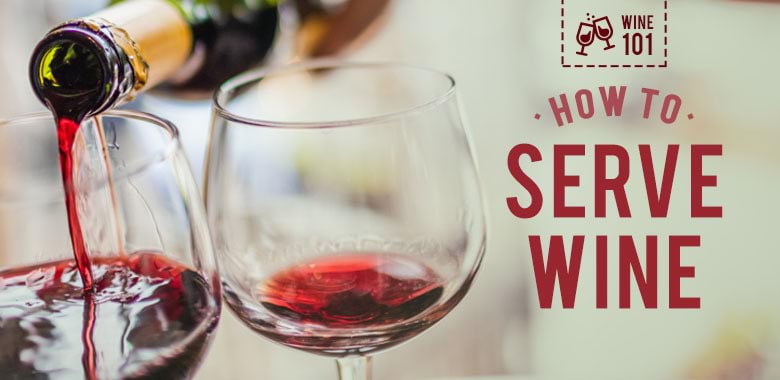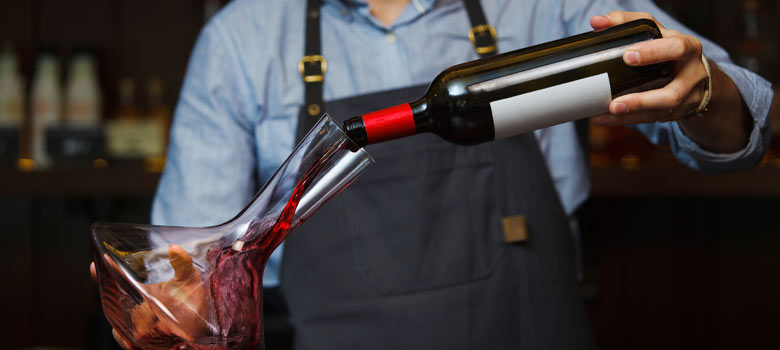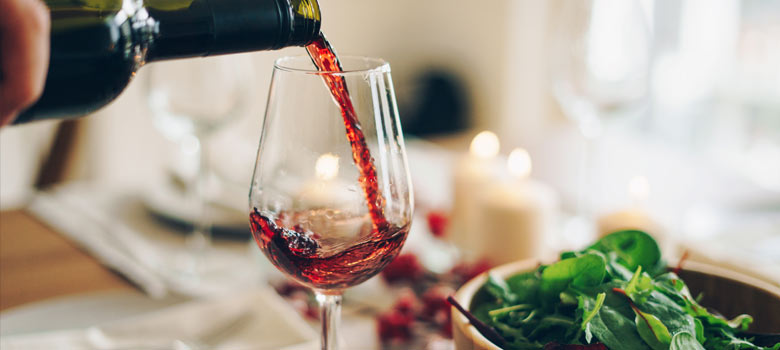
Wine
How to taste wine
Our top 5 tips for pouring, serving and storing wine
Enjoying wine isn’t rocket science, but there are ways to bring a little extra tjuz to the experience. Add a smidge of sommelier class to your afternoon or evening with these handy tips for getting the most out of your glass of wine!
1. Choosing the right wine glass
For an all-purpose white wine glass, choose a long stem with a good-sized bowl so there is plenty of space for the wine to breathe. Always hold the glass by the stem to ensure the bowl is not heated by your hands. Go for a smaller bowl with lighter-bodied wines to preserve their delicacy, and a larger one for Chardonnay to bring out its creamy texture.
Red wines go best with a bigger bowl – like with Bordeaux or Burgundy glasses – letting you get your nose in to smell the aromas. It also brings more air in to release the flavours and soften the tannins – perfect for varieties like Cabernet and Shiraz, as well as for unlocking the flavours of new world wines like Tempranillo and Sangiovese.
For Sparkling wines, the classic flute allows the bubbles to gather at the bottom of the glass then shoot up to the top, capturing the aromas and flavours and presenting a stunning display of sparkles, while for more aged or complex examples a tulip-shaped glass will help open up the aromas and flavours.
Our Tasting Panel agree that you can’t go wrong with Schott Zwiesel wine glasses. Durable, stylish and dishwasher safe, they really deliver the goods.

2. The ideal serving temperature for wine
Most people serve their red wines straight from the shelf, and their whites straight from the fridge – and that’s ok! While there’s no harm in doing so, if you really want to enjoy your wines at their best, it helps to know that each wine has an optimal serving temperature.
Take red wine. If served too warm, the alcohol will dominate, masking those lovely subtle flavours. And with Australia being a warmer country, most red wines are being served above their ideal temperature. Cabernet and Shiraz are at their best between 16-18 degrees, while lighter reds like Pinot Noir are at their peak between 12-14 degrees. We recommend popping them in the fridge for about 20-30 minutes before serving for best effect.
Similarly, white wines will have their delicate flavours suppressed if served too cold, meaning it’s a good idea to take them out of the fridge for a little while before serving. Aromatic whites like Pinot Gris and Sauvignon Blanc really show themselves at a lightly-chilled 6-8 degrees.

3. Decanting your wine
When you’re wanting to store your wines, oxygen is your greatest enemy. But when you’re pouring yourself a beautiful red to drink now, it – and a trusty decanter – becomes your best friend!
The prime benefit of decanting is that it lets your wine and oxygen combine. Wine feeds on oxygen when it’s released, giving it the best chance to open up and allowing the fruit to prosper, the structure to soften, and the wine to be at its best for tasting.
In the old days, a wine that had a cork and was deemed worthy, or was of good providence, was meant to be decanted, to separate it from its sediment. The advent of the screwcap has changed all this. As screw-capped wines arrive tighter and more fine-boned than their predecessors under cork, a bit of air can help release primary fruit and aid texture.
In terms of time, newer wines can be left in the decanter and you’ll notice they open up over the course of a few hours. Older wines, however, do not need more than an hour as they will start to fall away in the decanter and fruit can become stripped quite quickly.
Decanting will even improve less expensive wines, often helping get rid of the unpleasant odour of sulphur dioxide – you may even fool your friends into thinking you’ve forked out for a top drop!

4. How to pour wine like a pro
While a social drink is a deliberately informal affair, sometimes you might want to bring a bit of ritual and flair to the occasion.
If you wanted to go full table service, wrap a napkin around the bottle’s neck, grab the bottle anywhere below its shoulder, and keep the label facing outward to show off the wine you’re pouring. Give the bottle a turn as you’re completing the pour, to prevent any drops from spilling.
Pouring consistent servings is also a readily-acquired skill. A standard pour equates to about a ¾ measuring cup – slightly less for white wines – so you can train your eye easily by filling one with water and tipping into the glass. This will usually result in a glass that’s roughly 1/3 full for standard-size wine glasses, leaving plenty of room for you or your guests to swirl the wine,
Or you can let the glass itself tell you when to stop! A casual rule of thumb is to fill to the point just below where the curvature of the glass bowl begins to narrow.

5. Storing opened wine – how long does it last?
If you’re like us and love good wine, there’s little chance of a bottle lasting long enough to risk losing its drinkability. If you do find yourself with an opened bottle or two at the end of an evening, the below will steer you right.
RED WINES
When sealed and stored in a cool, dark place or a fridge, red wines like Cabernet, Shiraz, Merlot and Malbec can last for around four days. As a general rule, red wines with higher tannin and acidity tend to last longer once opened. Late harvest reds can also stay fresh for up to four days.
LIGHTER WHITE WINES
The light-weight whites like Pinot Grigio, Pinot Gris, Sauvignon Blanc and blends, Riesling, Vermentino and Gewürztraminer should remain fresh for up to two days. Make sure the wine is sealed with a screw cap or stopper and stored in the fridge. You’ll probably notice a change in taste as the wine oxidises and the fruit characters diminish, becoming less vibrant.
FULLER-BODIED WHITE WINES & ROSÉ
When sealed with a screw cap, cork or stopper and stored in the fridge, three days is the use-by for a Rosé or full-bodied white like Chardonnay, Fiano, Roussanne, Viognier and Verdelho. Oaked Chardonnay and Viognier tend to oxidise more quickly because they are exposed to additional oxygen during the pre-bottled ageing process.
SPARKLING
Once popped, Champagne, Prosecco, Sparkling Whites and Sparkling Reds quickly lose their carbonation or fizz. Use a Sparkling wine stopper and store it in the fridge for no more than two days.
There you have it – your go-to guide on how to serve wine! Want to take your wine knowledge to the next level? We’ve got you covered. Check out our Do’s and Don’ts of Good Wine Storage guide for more on keeping your wines at their best, or Adam Wall’s Wine Hints and Tips. Now if you’ll excuse us, we have some open bottles we need to take care of in the proper fashion…